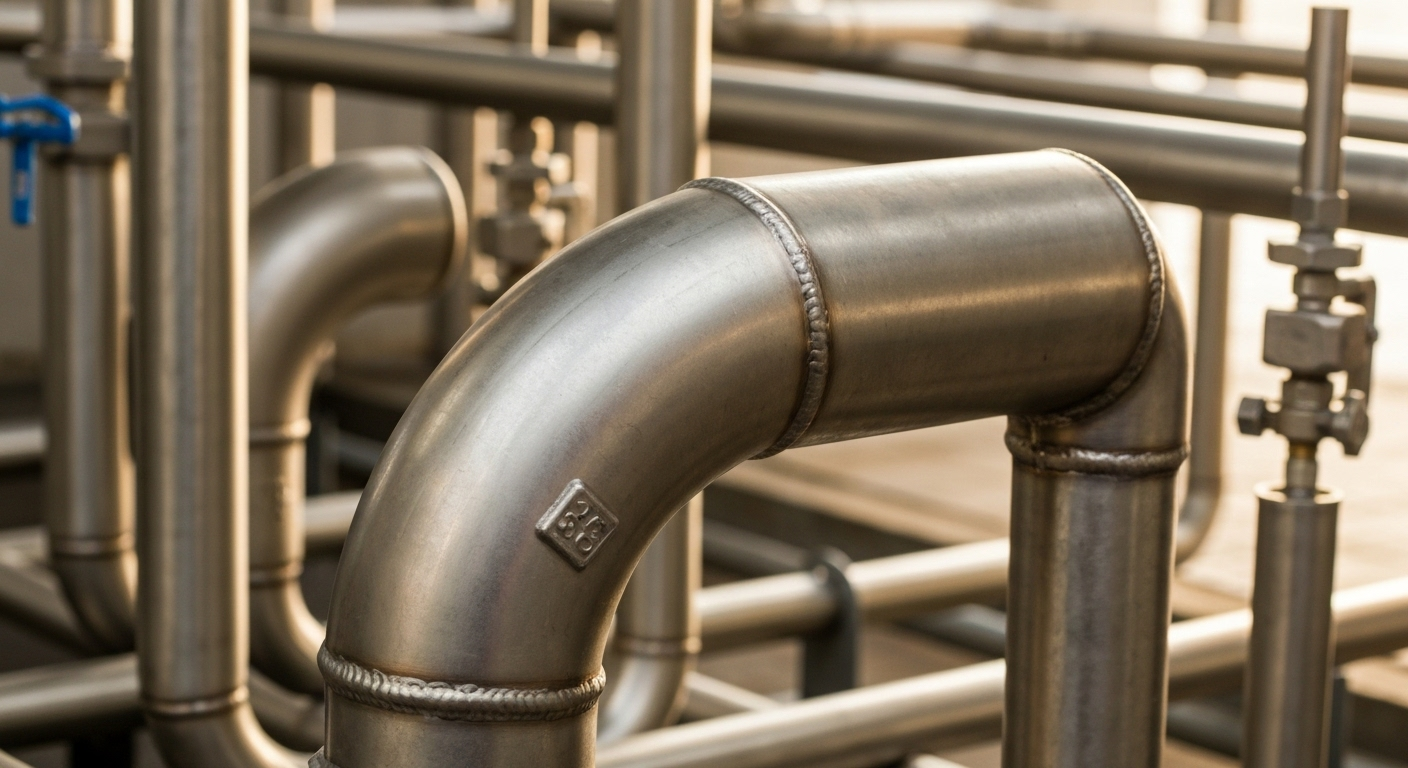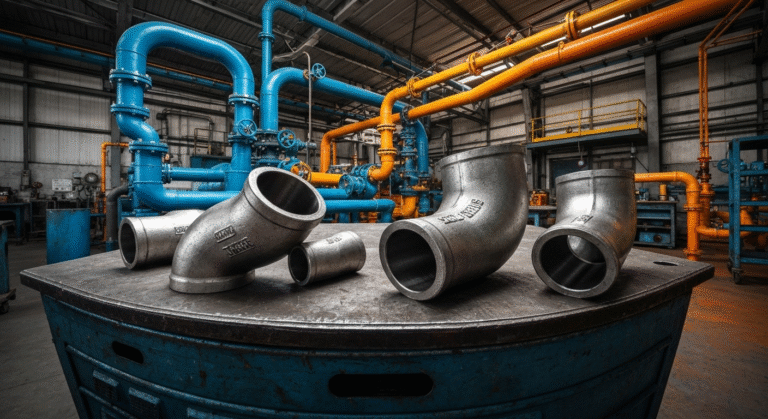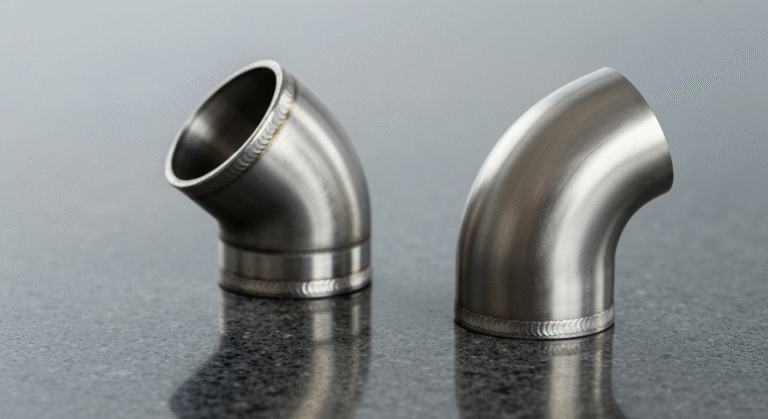-
Промышленная зона Иньчжуан, уезд Мэнцюнь, город Цанчжоу, провинция Хэбэй, Китай

Essential Guide to Stainless Steel Elbow Pipe Fittings

Основные моменты
Here is a summary of the essential points covered in this guide:
- Stainless steel elbow pipe fittings are fundamental components for changing the direction of flow in a piping system.
- Elbows are categorized by angle (45°, 90°), radius (long or short), and connection type (butt weld, threaded, flanged).
- Material grades like 304 and 316 stainless steel offer different levels of corrosion resistance for various applications.
- Proper selection requires matching the elbow’s size, schedule, and material to your system’s pressure and temperature requirements.
- Understanding dimensional specifications is key to ordering the correct pipe fittings, long before you need to enter any payment or credit card information.
Введение
A stainless steel elbow is a key pipe fitting that helps change the way something flows in a pipe system. The fitting is built strong and made for the times when your pipes need to go around corners or past things that might get in the way. Because it is made of stainless steel, this elbow fitting does not rust and will last a long time. People use these elbows in many kinds of places, like the big factories or at work in shops. If you know the job this fitting does and learn about the different types it comes in, you will be able to set up a good and strong pipeline that works well.
Types of Stainless Steel Elbow Pipe Fittings

Stainless steel elbow pipe fittings help you join two pipes at an angle. They change the way liquids or gases flow. This helps you set up pipes in many ways so they can go around things like machines or other barriers. This is why they are so useful in almost any piping system. The way these fittings are made lets the flow move easily, keeping the pressure and efficiency of the system steady.
You can sort these elbow fittings by a few important details. The main ways they are grouped are by the angle of the turn, the radius of the bend, and how the fitting connects to the pipe. Each kind has its own job. To choose the best one, you need to think about space, flow speed, and how much pressure there will be. The next sections will talk more about these types.
45-Degree vs. 90-Degree Elbows: Applications and Selection
When you start to set up a piping system, the first thing to think about is picking the right angle for your elbow fittings. The two main types you will see are the 45-degree and 90-degree stainless steel elbows. The 90-degree elbow, which some people call a right-angle bend, helps pipes make a sharp turn. It is the one most people use to bring pipes around corners.
On the other hand, a 45-degree stainless steel elbow gives you a smoother turn. This means it slows down the change in direction, which can cut down how much friction and pressure are lost as water or gas flows through. This is important if you want to keep the flow going fast and stop too much swirling inside your pipes.
So, which one should you choose? It will all depend on what your piping system needs.
- Use a 90-degree elbow when you want to make a sharp turn and space is very tight.
- Use a 45-degree elbow when you want the pipes to turn gently for better flow and less loss of pressure.
- Combine two 45-degree elbows if you want the pipe to curve with a big, smooth bend instead of a sharp angle like the standard 90-degree elbow.
Both types of stainless steel elbows help you build a good piping system that works well and saves you trouble later on.
Butt Weld vs. NPT Threaded Elbows: Key Differences
The connection method is another critical factor that differentiates stainless steel elbow types. The two primary methods are butt weld and NPT (National Pipe Taper) threaded connections. Butt weld elbows feature beveled ends that are welded directly to the adjoining pipes. This process creates a strong, permanent, and leak-proof seal, making it the preferred choice for high-pressure, high-temperature, or critical process lines where joint integrity is paramount.
NPT threaded elbows, on the other hand, have tapered threads that screw onto the corresponding threads of a pipe. This method allows for easier assembly and disassembly, which is advantageous for systems that may require future maintenance or modifications. However, threaded connections are generally used for smaller diameter pipes and lower pressure applications, as they can be a potential source of leaks if not sealed properly.
Understanding these differences is key to selecting the right fitting.
Характеристика | Butt Weld Elbow | NPT Threaded Elbow |
|---|---|---|
Connection | Permanent, welded joint | Removable, threaded joint |
Прочность | Very strong, leak-proof | Good strength, requires sealant |
Best For | High-pressure, high-temperature systems | Low-pressure systems, easy assembly |
Installation | Requires skilled welding | Simple screwing, no special skills |
Material Grades and Specifications

The way a stainless steel elbow works depends a lot on the material grade and if it meets right manufacturing standards. Different grades of stainless steel give you different levels of resistance to rust, strength, and how much heat they can take. The most often used stainless steel grades for elbow pipe fittings are 304 and 316. Each one works best in different conditions.
But it’s not only about the material grade. You should look at technical things like how thick the walls are and what pressure the fitting can handle. This makes sure the part can take the work your system needs it to do and can keep you safe. In the next sections, we will look at the most used grades and help you understand the schedule choices. This way, you can pick a stainless steel fitting that works well and keeps things safe.
Comparing 304 vs. 316 Stainless Steel Elbows
Choosing between 304 and 316 stainless steel elbow fittings is a choice many people face. Grade 304 is the the most used type. It gives good protection against rust, is easy to shape, and easy to join. This one is also a lower cost for many uses. It works well for food jobs, water lines, and regular pipes in places that do not have strong chemicals.
The main difference comes from what is inside each type and how well they stand up to rust. Grade 316 stainless steel has molybdenum added. This makes it much better at fighting rust, especially from salts or tough cleaning products. Because of this, 316 is the better pick for places that are rougher.
Go with a 316 stainless steel elbow for places near the sea, in chemical plants, or where things touch salty water and there is a bigger chance of small pits or cracks. While it costs more at the start, it will last longer in hard places and can help you spend less on fixing or replacing things over time.
Understanding Schedule Options and Pressure Ratings
When you pick a stainless steel elbow, you will see a “schedule” number. What does this mean? The schedule, sometimes written as SCH, tells you the wall thickness. A higher schedule means the wall is thicker. When the wall is thick, the fitting can handle more pressure inside. This is very important to keep your piping system safe and strong.
There are a few common schedule choices for stainless steel elbows. These are SCH5S, SCH10S, SCH40S, and SCH80S. The “S” at the end shows that it is made for stainless steel products. The amount of pressure it can handle will also depend on the material and the temperature you use it at. Still, the schedule number gives you a simple way to know how strong the fitting will be.
If you want to pick the right fitting, here is what you need to do:
- Find out the highest pressure your system will have.
- Pick an elbow with a schedule and pressure rating that is more than what your system needs.
- Make sure the elbow’s schedule matches the schedule of the pipes you connect, so you get a smooth flow inside.
Sizing, Compatibility, and Standards
Making sure the size and fit are correct is important if you want your pipes to work well and not leak. Stainless steel elbow pipe fittings are made to follow strict rules set by the industry. These rules help decide things like their size, what they are made from, and how much they can vary. Two key rules are ASTM A403, which covers stainless steel parts, and ASME B16.9, which sets the size for buttwelding fittings made in factories. By following these standards, you can be certain that the parts from different companies will work together.
Picking the right size for your stainless steel fittings is not just about matching the pipe’s size. The radius of the elbow also matters, and you need to think about how it fits in the whole setup. The next part will show how to measure an elbow so you know you have the right one before you put it in.
How to Measure Elbow Pipe Fitting Size and Ensure System Compatibility
Accurate measurement is key to making sure a stainless steel elbow fits well in your system. The most important thing to measure on an elbow is its “center-to-end” distance. This is the space from the center of the elbow’s radius to the outside end of the fitting. This tells you how much room the fitting will use when you put it in.
For the elbow to fit with the rest of your piping, you must match these things with the connecting pipe: the nominal pipe size (like 2 inches), the material type (like 304 stainless steel), and the wall thickness (for example, SCH40S). If the parts do not match, you could have a poor fit, flow problems, or a weak connection.
To get the right stainless steel elbow for your work, do the following:
- Confirm the nominal pipe size (NPS) and schedule of your pipe you already have in place.
- Measure the center-to-end distance to make sure the elbow’s shape is right, especially if you are swapping out an old part.
- Check the elbow’s radius (is it long or short) to make sure it fits the flow you want and the space you have.
Заключение
To sum it up, it is important for people who work in plumbing or industry to know about stainless steel elbow pipe fittings. These fittings have different types and grades, and each one helps with a specific job or need. There are 45-degree and 90-degree elbows, and picking the right one can help your piping system work better. You also need to know what materials are used and if they match your setup. This helps your pipes last longer and perform well. If you use these fittings the right way, your work will be safer and more reliable. If you want to learn more about stainless steel fittings or want advice just for you, you can always ask for a consultation.
Часто задаваемые вопросы
When should I choose a long radius versus a short radius elbow?
If you need a stainless steel elbow for high-flow or high-pressure piping, go with a long radius (LR) type. This helps cut down turbulence and pressure drop. If you need to save space and flow is not your main worry, then use a short radius (SR) elbow. It fits well in tight places because it is more compact and works better for layouts where space matters most.
Are stainless steel elbows compatible with other metal piping systems?
Stainless steel elbows can get connected to other metals, but you have to be careful. When you join metals that are not the same, it can cause galvanic corrosion. To stop this, you should use the right dielectric fittings or gaskets. This helps keep the metals apart and stops your piping system from failing too soon.
What maintenance is required for stainless steel elbows in industrial use?
Stainless steel elbows are easy to take care of. They do not rust much, so they last longer. You should look at them now and then to see if they have leaks or any damage. Keep them clean, especially if you use them in places that must be hygienic. If you store elbows before use, check them often. Make sure they stay clean and dry before you put them in.
What are these stainless steel elbow fittings called?
Stainless steel elbow fittings are commonly referred to as “elbow pipe fittings.” They are designed to change the direction of piping systems, typically at angles like 45 or 90 degrees. These durable fittings are essential for various applications in plumbing, HVAC, and industrial systems, ensuring efficient flow management.
What are these stainless steel elbow fittings called?
Stainless steel elbow fittings are commonly referred to as “elbow pipe fittings.” They are designed to change the direction of piping systems, available in various angles such as 45 or 90 degrees. These fittings ensure smooth flow and are essential for maintaining proper alignment in plumbing and industrial applications.


